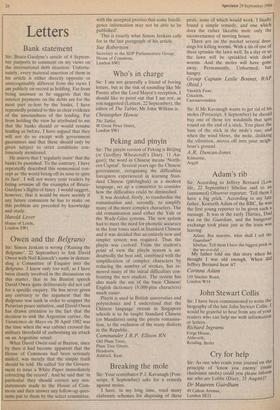Peking and pinyin
Sir: The pinyin version of Peking is Beijing (re Geoffrey Wheatcroft's Diary, 11 Au- gust); the word in Chinese means 'North- ern Capital'. Several years ago the Chinese government, recognising the difficulties foreigners experienced in learning Stan- dard Chinese (peterighua) as a modern language, set up a committee to consider how the difficulties could be diminished.
It was decided, firstly, to standardise the romanisation and, secondly, to simplify many of the more complex characters. The old romanisation used either the Yale or the Wade-Giles systems. The new system had to meet the need for phonetic accuracy in the four tones used in Standard Chinese and it was decided that an entirely new and simpler system was required. Thus the pinyin was evolved. From the student's point of view the pinyin system is un- doubtedly the best and, combined with the simplification of complex characters by reducing the number of strokes, has re- moved many of the initial difficulties con- fronting the new student. The system has also made the use of the basic Chinese/ English dictionary (8,000-plus characters) much easier.
Pinyin is used in British universities and polytechnics and I understand that the Chinese language stream in Singapore schools is to be taught Standard Chinese (or Mandarin) .using the pinyin romanisa- tion, to the exclusion of the many dialects in the Republic.
Commander J.B.P. Ellison RN .
Old Plum Trees, Plum Tree Green, Eleadcorn, Ashford, Kent.














































 Previous page
Previous page